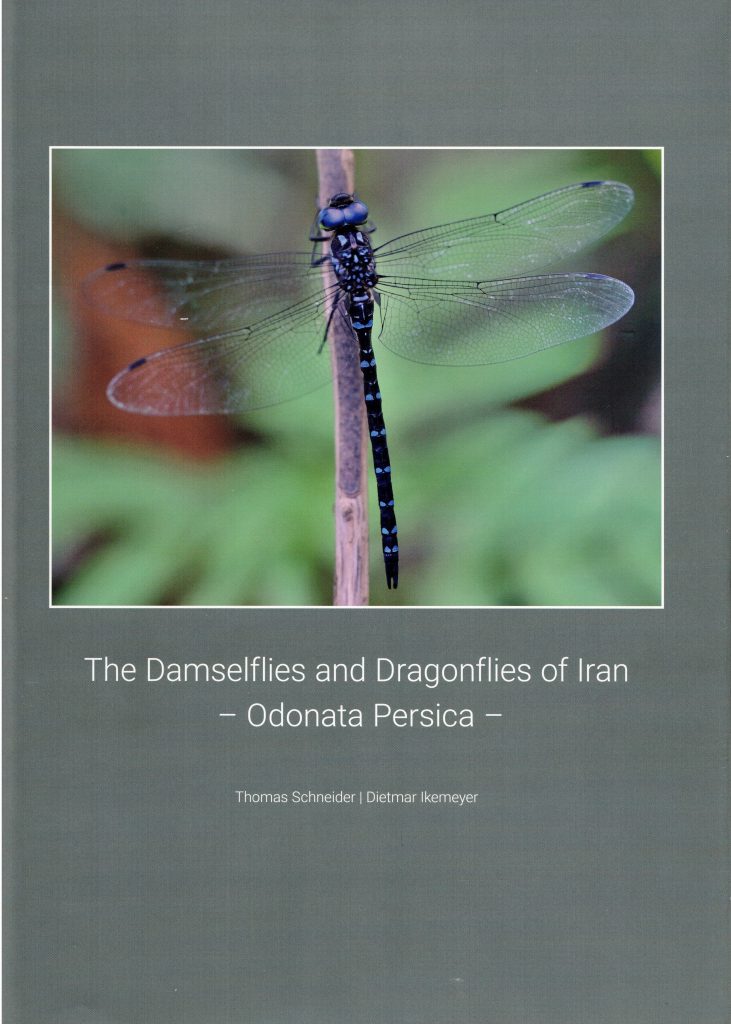The Damselflies and Dragonflies of Iran – Odonata Persica –

Autoren: Thomas Schneider & Dietmar Ikemeyer
Erscheinungsjahr: 2019
In englischer Sprache!
Seitenzahl: 255
Format: 29,5cm x 21cm (DIN A4 – gebunden)
etwa 430 Bilder
ISBN: 978-3-931921-23-1
Preis: 90,00 €
Dieses Buch ist die erste umfassende Publikation über Libellen im Iran.
Innerhalb von sechs Jahren, von 2013 bis 2018, reisten die Autoren 16 Mal in fast jede iranische Provinz, um die dortige Libellenfauna zu untersuchen. Infolgedessen konnte eine neue Libellenart beschrieben werden: Aeshna vercanica.
Und andere Libellen wurden zum ersten Mal im Iran registriert. Dies sind: Lestes dryas, Lestes macrostigma, Platycnemis kervillei, Coenagrion puella, Coenagrion pulchellum, Coenagrion ponticum, Coenagrion lunulatum, Crocothemis sanguinolenta, Brachythemis contaminata, Trithemis pallidinervis und Caloptery s. tschaldirica.
Insgesamt werden 103 Arten fotografisch dargestellt. Für die detaillierten Verbreitungskarten wurden Daten aus früher veröffentlichter Literatur und verfügbare unveröffentlichte Daten über iranische Libellen bis Ende 2018 erfasst und in eine Datenbank eingetragen.
Weitere Informationen zu biometrischen Daten, Bestimmung, Lebensraum und Taxonomie werden gegeben.
Eines der Hauptziele dieses Buches ist es, zum Erhalt des Naturerbes der iranischen Libellenfauna beizutragen, die durch die Wasserkrise und all ihre Auswirkungen stark gefährdet ist.
Das Buch hat ca. 250 Seiten und erscheint in DIN A4 Hochformat (29,5 cm x 21 cm). Zu den behandelten 103 Arten gibt es für jede! Art eine Verbreitungskarte und es enthält ca. 430 Fotos (pro Art 2-5, plus weitere in der Einleitung). Das Buch (mit Fadenbindung) besitzt ein Hardcover mit Schutzumschlag. Preis 90 €
Englische Version:
As a result one dragonfly could be described as a new species, Aeshna vercanica, and other dragonflies were recorded in Iran for the first time. These are: Lestes dryas, Lestes macrostigma, Platycnemis kervillei, Coenagrion puella, Coenagrion pulchellum, Coenagrion ponticum, Coenagrion lunulatum, Crocothemis sanguinolenta, Brachythemis contaminata, Trithemis pallidinervis and Calopteryx s. tschaldirica.
This book is the first comprehensive publication about damselflies and dragonflies in Iran. Within a period of six years, from 2013 to 2018, the authors travelled 16 times to almost every Iranian province to investigate the indigenous dragonfly fauna.
In total 103 species have been illustrated by photography. For detailed distribution maps data from formerly published literature and available unpublished data about Iranian dragonflies were screened up to the end of 2018 and entered in a database. Further information on biometric data, identification, habitat and taxonomy is given. One of the key objectives of this book is to help preserving the heritage of the Iranian dragonfly fauna which is gravely endangered by the water crisis and all its repercussions. There are distribution maps and 2 to 5 colour photos of each of the 103 species treated in the book (altogether there are about 430 photos).